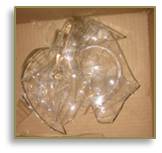Now that we are moved in, relatively organized, and somewhat healthy,
it’s time to compile our insurance claim for all the things the moving company
broke. I packed very carefully, using
newspaper, bubble wrap and even towels at the bottom of boxes containing
delicate things. I marked those boxes
FRAGILE. Yet, when we started to unpack,
we began hearing the tinkle of broken glass and china. As we went along, I had to be very careful
reaching into boxes because I didn’t know what I was going to find.
It’s a painful process, made more painful by knowing that none of this
would have happened had we been able to use Precision Moving. They had done work for us before and always
did an excellent job. But they were
booked up that weekend so we used Casey Movers instead. Casey had wonderful references on their site
and the guys worked their butts off on a very cold weekend. They even helped me keep my plants
alive. We thought the move had gone well
until we opened those boxes. And there’s
at least one I haven’t found yet, with vases and other glassware. It’s here somewhere—I keep looking—but we
only have 30 more days to get this insurance claim done.
One by one we put the broken objects into a part of the basement I
called the morgue. Seth took pictures
and now I’m compiling a list to go along with them and trying to attach values.
For some items, finding those values is easy. Dinnerware, for example. I just go to Replacements.com, search on the
company and the pattern, and get what it would cost to order a new piece. Crate & Barrel has their website. But what value do you attach to an heirloom
glass wine decanter or cachepot? Unlike on
Antiques Roadshow, these pieces
have no maker’s marks or manufacturer’s information—and no provenance—so all we
know is they were acquired somewhere in Poland or Russia from sometime in the
19th century. And what premium
do you assign for memories? In most
cases, these items came from Seth’s grandparents so the memories aren’t mine,
but still.
It raises the issue of whether things are important. Do you need the things to keep the
memories? As we get older, we move out of
the acquisition phase of life and into what the art museums call “de-accessioning.” That means getting rid of things and I’m all
for it. In entering this next phase, I
can’t get “broken up” about having fewer things in general but I would have
liked to make the decisions on which pieces went, and how. Now that it’s done, I just have to let go of
the damaged pieces, replace the (very) few things that I used, and focus more
on experiences. That was the plan
anyway. Maybe the move just helped
things along.


No comments:
Post a Comment